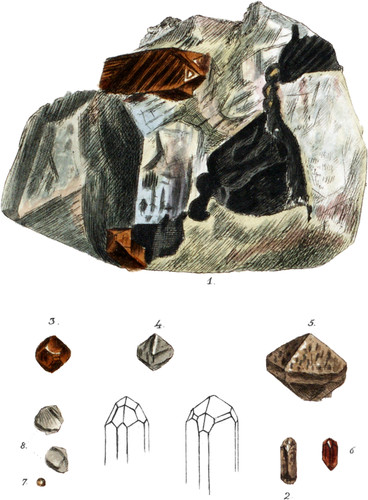 Enlarge
Enlarge
Exotic Mineralogy
Zircon, or Hyacinth
- Syn.
- Zirkon and Hiacinth. Kirwan, 1, 257. Werner.
- Zircon. Haüy, 2, 465. Tabl. 28. Bournon Catal. 24. Aikin. 184.
- Jargoon and Hyacinth of Jewellers.
The Hyacinth has of late years been found in many places besides the Isle of Ceylon, from whence it is imported for Jewellers. Usually its crystals are very small, and found in the beds of rivers among sand that appears to be either the debris of trap-rocks, or volcanic, or mixed with iron-sand, as in Ceylon, (see figs. 3, 4, and 6,) where they are also accompanied with oriental Ruby, Spinell, Tourmaline, &c. Sometimes the crystals are minute, but very clear and brilliant;—such accompany the Platinum from South America.
Larger crystals of a redish brown colour, and imperfectly transparent, arc found imbedded in Sienite at Friedrickschwarn in Norway, see figs. 1 and 2. Small crystals have been met with in Basalt, Trap, and Volcanic matter, in several parts, especially in Auvergne. In all these situations the crystals are perfect all round, and very rarely grouped together. The primitive form, according to Haüy, in an octohedron (which is represented with the edges truncated at fig. 5,) whose pyramids measure 82° 50′ upon each other; this is frequently modified into a four or eight-sided prism, with a four-sided termination, or into a dodecahedron with unequal rhomhoidal planes: the prism is sometimes terminated by acute eight-sided pyramids of which indications are shewn in fig. 2, and the outlines. Besides the crystallized form, Zircon is found in grains which are often colourless, or greyish, sec fig. 8, with a peculiar smoky tinge that distinguishes them from Diamonds, in place of which Jewellers are tempted to use them by the play of colours they exhibit when cut. This variety is more particularly called Jargoon by the artizans. The coloured varieties loose their colour by being heated without the transparency being injured.
Fig. 1 is taken from a specimen in the British Museum; the matrix is a Sienite, composed of grey Feldspar, with an internal reflection of blue, and Hornblende; containing also Pyrites and Molybdenum.
Fig. 7, a red grain from Expailly in France.
The different varieties of Zircon afford nearly the same constituents as appears from the following analyses:
| From Ceylon, by Klaproth. | From Expailly, by Vauquelin. | ||
|---|---|---|---|
| Zirconia | 69.0 | 70.0 | 66 |
| Silica | 26.5 | 25.0 | 31 |
| Oxide of Iron | 0.5 | 0.5 | 2 |
| Loss | 4.0 | 4.5 | 1. |
| 100.0 | 100.01 | 100 | |
| Zirconia | 65 |
| Silica | 33 |
| Oxide of Iron | 1 |
| Loss | 1 |
| 100. |
The sp. grav. varies from 4261 to 4721.

